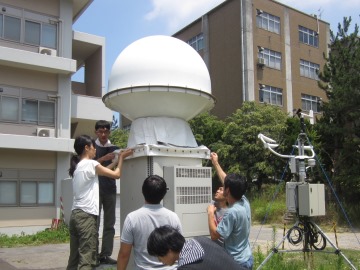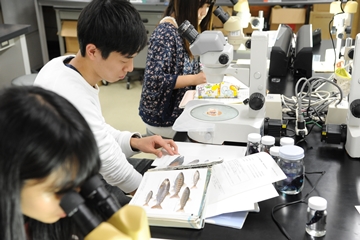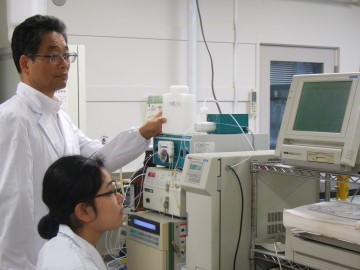Environmental meteorology
There is probably no natural phenomenon more familiar to us than the weather, such as the blowing of the wind and the falling of rain. Meteorology is also essential for comprehensively understanding the mechanisms of the global environment. Students will learn to understand various atmospheric phenomena, which are key to interpreting the global environment and its changes, based on the laws of physics, and to quantitatively evaluate them through theoretical aspects.

Meteorological Doppler radar that observes the movement of precipitation particles over Niigata
Paleoenvironmental studies
The past is the key to the future. By investigating the mechanisms and processes behind past Earth history events, we can understand the current structure of the Earth and predict future phenomena. This lecture will focus on the glacial-interglacial cycle, especially the period from the last glacial period to the present. Using the latest data from climatology, oceanography, topography, and geology, students will learn about the processes and mechanisms that created the current environment.

Class in Paleoenvironmental studies
Environmental analytical chemistry
In order to create a better living environment, it is essential to analyze hazardous chemicals in environmental samples such as air and water. However, if chemical analysis is performed inappropriately, chemicals that are not actually present may be detected, giving an incorrect assessment of the environment. In this lecture, students will acquire basic knowledge about analytical chemistry, with the aim of not only obtaining accurate analytical values but also acquiring the ability to verify the validity of the analytical values obtained.
Geomorphology
Terrain, which is the undulating form of the earth's surface that we usually see, can be classified hierarchically based on the formation process, and we can see the relationship between the terrain and people's lives. In the lecture, the formation process and topographical characteristics of topography, which is classified into three types: lowlands, terraces, and mountains, and further divide small topography into categories are explained. Students learn the relationship among small topography, people's lives (land use), and natural disasters, and how to read topographic maps.

Topographic observation on Niigata dunes
Biodiversity a, B, c
Various living things live on Earth. The related relationships between these organisms are currently being reexamined as a result of comparative genetic analysis. Biodiversity a focuses on plants, B focuses on animals, and c focuses on large phylogenetic groups of living things. Through these lectures, students understand the morphological and ecological characteristics found in each phylogenetic group and learn about the morphological and ecological characteristics and the diversity and universality found in the living world.

Observation of transparent fish skeleton specimens to learn about morphological diversity
Adaptation biology
Living things continue to evolve while adapting to various environments. In this lecture, we will discuss how animals and plants, which have abandoned their aquatic life and moved onto land and have evolved in a variety of ways, respond to the various stresses they receive from the environment, such as dryness, intense light, feeding damage from other organisms, and pathogenic bacteria. Students learn how people communicate, how they adapt, and how they develop the ability to adapt.
Natural environment science experiment C1, C2
In experiments C1 and C2, students will conduct experiments to quantify ionic components in water and measure gamma rays. These are measurement methods used for official analysis of various environmental measurements, such as chemical analysis of lake and river water, and measurement of environmental radioactivity. We also conduct experiments using state-of-the-art equipment used for ultratrace analysis and pesticide analysis, such as atomic absorption spectrometry, fluorescence photometry, Fourier transform infrared spectroscopy, and mass spectrometry.

Analysis of acid rain by ion chromatography